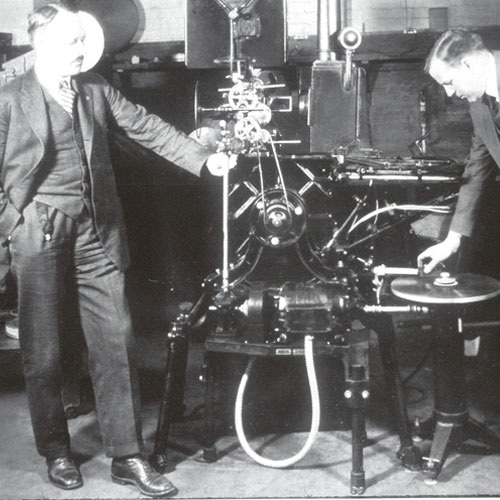In 1876, Alexander Graham Bell rushed to the patent office to claim his invention of the telephone. Before that, the only way to have a conversation with someone in real-time was in person. Now, it’s hard to imagine a world where technology isn’t driving our communications. This invention led to the creation of AT&T.
Say you learn about a new technology that’s coming out this year. That technology started off as an idea or concept long before it becomes a prototype. Then the potential for a prototype is brought about by design and engineering. The idea or concept goes through many stages before finally hitting the market.
If our AT&T scientists work hard for months to develop the actual new technology, think of our intellectual property groups as “future tellers” working years ahead to predict technology needs for a more connected world.
Check out when key technology breakthroughs actually happened.
- 1926 – Sound Motion Pictures
AT&T brought sound to Hollywood in the 1920s with the invention of Sound Motion Pictures. By creating a way to synchronize sound and picture, actors’ voices matched up with their moving lips! In 1926, Warner Brothers premiered Don Juan, the first full length film with a synchronized sound track of music and audio effects.
- 1929 – Broadband Coaxial Cable
Similar to our current-day need to switch to a software-defined network to handle massive mobile video traffic, 1920s AT&T engineers recognized the open wire and cable in use at the time couldn’t carry the high frequencies needed for the broadband systems of the future. Enter the broadband coaxial cable, the first broadband media. It made higher-capacity long distance circuits possible. But it also led to intercity transmission of moving images, which paved the way for television.
- 1947 – The Transistor
The transistor is an indispensable component of most devices we use today. It made the marriage of computers, devices and communication possible. It’s light-weight, tiny and doesn’t overheat – like its precursor the vacuum tube. The transistor, and the eventual creation of integrated circuits that contained millions of transistors, served as the foundation of modern electronics. Without this invention we would still have phones in our cars, but your phone would weigh around 80 pounds!
- 1954 – The Solar Cell
The first practical solar battery, consisting of an array of several strips of silicon (each about the size of a razor blade), could only convert 6% of the sunlight into useful energy. Just a few years later, solar cells of this design powered AT&T’s Telstar 1, the first active communications satellite launched by NASA.
- 1969 – Unix
AT&T Bell Telephone Laboratories researchers devised the UNIX computer-operating system in 1969. Just 2 years later, UNIX became the first truly portable computer operating system, designed to work on a wide range of computers. In the 1980s, UNIX and its variants became the most widely used operating system underlying the internet. Today, UNIX and its descendants continue to be the backbone of the internet, running on devices ranging from smartphones to supercomputers.
- 1972 – Automatic Switching for Mobile Communications
One of the first inventions that allowed us to stay connected on the go isAutomatic Switching for Mobile Communications. The technology lets your cellphone automatically transfer from one tower to another as you’re driving down the road.
- 1988 – TAT-8
TAT-8 was the first fiber-optic cable that stretched across an ocean and had a capacity of 40,000 calls. That’s 10x more capacity than its thicker and heavier precursor, which used the older copper coaxial cable technology. AT&T, British Telecom and France Télécom led the consortium that built TAT-8, which spanned a seabed distance of 5,846 km between North America and Europe.
- 1995 – Machine Learning
We pioneered a new breed of machine learning algorithms, including Support Vector Machines and AdaBoost. These algorithms are the heart and soul of all machine-learning research worldwide. Today, you’ll find these as large-margin classifiers for natural language processing and data mining.
- 2001 – Natural Voices
We released AT&T Natural Voices, an advanced text-to-speech (TTS) engine providing human-like speech in a variety of voices and languages. Our work surrounding the properties and analysis of human speech dates as far back as 1936, when a scientist at AT&T Bell Laboratories invented the world’s first electronic speech synthesizer. It required an operator with a keyboard and foot pedals!
- 2012 – NetBond
We launched AT&T NetBond®, a service that taps software-defined networking technologies so businesses can bring the cloud within their VPN network. The benefits? They can avoid exposure to the public internet and mitigate security and performance risks. AT&T NetBond exists because of Research’s patented IRSCP (Intelligent Routing Services Control Point), an early SDN technology.
- 2013 – ECOMP
ECOMP is the engine that powers our software-centric network. A system like ECOMP allows us to build our next generation cloud-based network in a vendor agnostic way, giving us great flexibility for deploying network function virtualization in our new software defined network. And it lets us rapidly on-board new services that our customers want. ECOMP is one of the most challenging, complex and sophisticated software projects in AT&T’s history.
After taking a trip down memory lane, think about the technology you use the most and why it’s important to you.
AT&T has a rich history of delivering keystone technologies – all made possible by the work of inventors with a keen eye for identifying opportunities and acting quickly.
PR Archives: Latest, By Company, By Date
